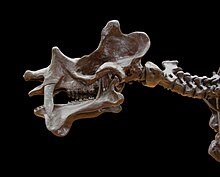User:UWotMEight/sandbox
| Uintatherium Temporal range:
| |
|---|---|

| |
| Skeleton of Uintatherium anceps at the National Museum of Nature and Science, Tokyo, Japan | |
| Scientific classification | |
| Kingdom: | |
| Phylum: | |
| Class: | |
| Order: | |
| Family: | |
| Genus: | Uintatherium Leidy, 1872
|
| Species | |
| |
| Synonyms | |
|
Dinoceras Marsh, 1872 | |
Uintatherium, ("Beast of the Uinta Mountains") is an extinct genus of herbivorous mammal that lived during the Eocene epoch; two species are currently recognized, U. anceps from the United States during the Early to Middle Eocene, and U. insperatus of Middle to Late Eocene China.[1]
Their fossils are the largest and most impressive of the finds at the excavation of Fort Bridger in Wyoming, and were a focal point of the Bone Wars between Othniel Charles Marsh and Edward Drinker Cope.
Description
[edit]Uintatherium was a large browsing animal. Its most unusual feature was the skull, which is both large and strongly built, but simultaneously flat and concave: this feature is rare and not regularly characteristic of any other known mammal except in some brontotheres. Its cranial cavity was exceptionally small due the walls of the cranium being exceedingly thick. The weight of the skull was mitigated by numerous sinuses permeating the walls of the cranium, like those in an elephant's skull.

With a length of about 4 m (13 ft), 1.70 m (5.6 ft) tall and a weight up to 2.25 tons, they were similar to today's rhinoceros both in size and in shape, although they are not closely related.[2]
The large upper canines might have acted as formidable defensive weapons, and superficially resembled the canines of saber-toothed cats. Sexually dimorphic, the teeth were larger in males than in females. However, they also might have used them to pluck the aquatic plants from marshes that seem to have comprised their diet.

The skulls of the males bore six prominent knob-like ossicones that grew from the frontal region of the skull. The function of these structures is unknown. They may have been of use in defense and/or sexual display. Uintatherium went extinct about 37 million years ago, presumably due to climate change and competition with perissodactyls, such as brontotheres and rhinos.
History
[edit]Doctors James Van Allen and Joseph Corson Carter discovered the first fossil of Uintatherium in July 1872, during the first visit of Joseph Leidy in Fort Bridger. Carter and Corson, collaborators of Leidy in his excavations in Wyoming, found a fragment of skull, fragments of upper jaw and below (along with some teeth), a humerus and other bones, including a tusk twenty centimeters long. Leidy described these fragments, giving them the name Uintatherium robustum, and announced the discovery to the Academy of Natural Sciences.[3][dead link]
Fossils
[edit]A cast of a Uintatherium skeleton is on display at the Utah Field House of Natural History State Park. The skeleton of Uintatherium is also on display at the Smithsonian National Museum of Natural History in Washington, DC.[4]

Fossils of U. anceps have been found in the Bridger and Wakashie rock formations, in the states of Wyoming and in Utah near the Uinta Mountains, which are commemorated in the generic name. An almost intact skull of U. insperatus was found in the lower part of the Lushi Formation of the Lushi Basin in Henan Province, China.[1]
References
[edit]- ^ a b Tong, Yongsheng (1981). "A SKULL OF UINTATHERIUM FROM HENAN" (PDF). Vertebrata Palasiatica. XIX (3): 208–214.
{{cite journal}}: Unknown parameter|coauthors=ignored (|author=suggested) (help); Unknown parameter|month=ignored (help) - ^ http://www.enchantedlearning.com/subjects/mammals/Iceagemammals.shtml
- ^ http://www.ansp.org/museum/leidy/paleo/uintatherium.php>|Academy of Natural Sciences
- ^ http://paleobiology.si.edu/geotime/main/htmlversion/evidence/eoc_02.html

